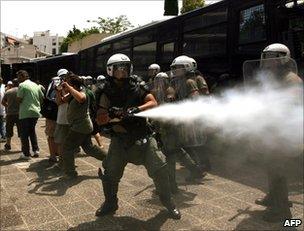London riots: Europe's lessons in policing
- Published
- comments

It has been part of the European patch - protest, riot, rage against austerity, anger at changes to the retirement age, fists clenched against global capitalism.
It is useful to compare the European approach to disorder with that in the UK.
Two recent conversations with UK-based TV producers surprised me. Both had covered protests in London. One was at a weekend when some demonstrators had got inside the Fortnum and Mason food store in Piccadilly.
Afterwards the producer described mobs attacking shops. The strange part was that for long periods no police were to be seen. The rioters had the streets to themselves.
A second conversation related to the day of student protests that resulted in a partial occupation and attack on political offices at Millbank. The police intelligence seemed negligible and for long parts of the afternoon they were outnumbered and ineffective.
I had been involved in the coverage of G20 protests in the City of London. They are remembered for the death of an individual at police hands. But leaving aside that tragic incident the approach of the police was to stand back, photograph incidents and then investigate later. The tactic was to contain rather than be pro-active.
In the current crisis many people are asking why the police stood by when violence and arson was happening around them?
Snatch squads
The question that hangs over British policing is this: have the number of investigations, inquiries and tragic mistakes left the force fearful of disapproval, of being accused of insensitivity? Have they lost their determination to act swiftly and resolutely?
The European experience is instructive. It is true that no police force gets public order right all the time.
Last year the French police had to deal with wide-scale protests over pension reform. Certainly in Paris they deployed large numbers of CRS riot police and gendarmes. Often the numbers of police overwhelmed the protesters. The impression given was that the police wanted to intimidate protestors from starting unrest.
At demonstrations they employed snatch-squads: teams of up to 10 men in plain clothes who went into a crowd and pulled out those they regarded as "les casseurs" - "the breakers".
Again they were pro-active when demonstrations ended. One night I watched them swamp La Place de la Bastille. They liberally and sometimes controversially used pepper spray and tear gas but they psychologically had the upper hand and those who might have had riot in mind dispersed.
However it often seems that the French police show a determination to defend the centre of Paris that does not extend to the suburbs. In 2005 when there were riots in the suburbs protesters were able to torch 10,000 vehicles.
The police not only stood by but were clearly reluctant to enter some estates that effectively became no-go areas.
But in Paris itself - certainly last year - they appeared confident, with good intelligence.
Public support
In Greece riots have been a feature of the past 18 months as the country is forced to embrace austerity in exchange for a bailout from the EU and IMF.
Initially the police appeared to lack a strategy. Small groups were often isolated and they rarely engaged close-up with the rioters, who freely ripped up pavements for ammunition.
History too played a part in the police hesitancy. In 2008, a 15-year-old had been killed by cops and that set off days of rioting. When there was unrest the police were content to be defensive but not to actively intervene.
Then last year a bank was fire-bombed and three people died including a pregnant woman. There was a wave of disgust and, for a period, the protests subsided. After that the police seemed emboldened.
During protests outside parliament in July they fired hundreds of volleys of tear gas and stun grenades. There was some destruction by protestors but when it seemed that anarchists were about to set fire to a bank, the police moved in. They were much more determined than the previous year.
In Belgium they like water cannon. They are frequently deployed outside the European Commission or at demonstrations. The police regard them as highly effective. Protesters often complain that the Brussels police are heavy-handed but they are confident in their tactics.
Last December in Rome I watched as protestors attacked banks. There were no police present. They were protecting the approaches to parliament with tear gas.
They, too, are a force that experienced a long investigation after the G8 riots in Genoa where they were judged to have acted too aggressively after two days of unrest. Their approach - certainly last December - seemed static, passive and content to cede control of some streets to demonstrators.
What emerges is that there is never one answer to unrest. What does appear important is the mindset of the police officers and their units. In order to be bold and assertive they need to be confident, and confidence grows from public and political support.
For part of the battle on the streets is psychological. A mob smells uncertainty. In Hackney yesterday young men attacked shops within sight of police lines. They felt the streets belonged to them. That, too, is the lesson from Europe. History or controversy weighs heavily on forces facing unrest.